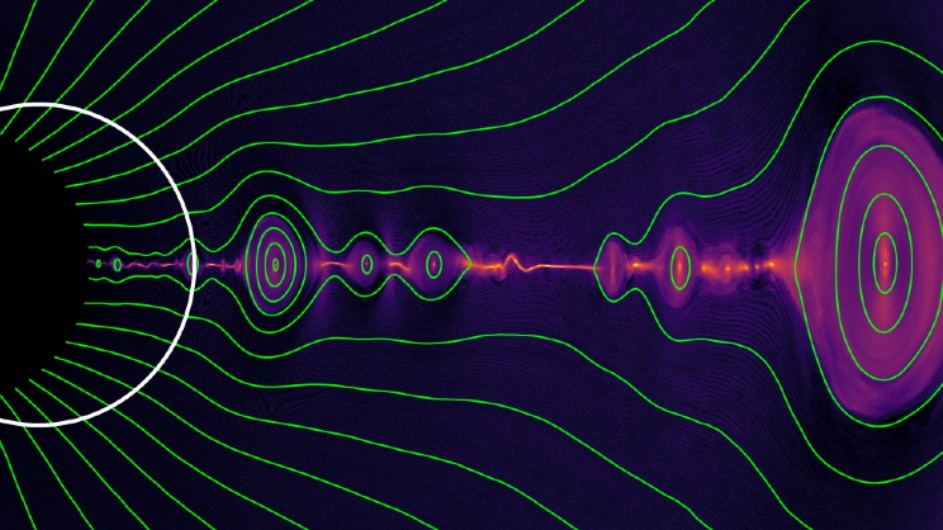In Virtual Outer Space, a Black Hole Sheds Its Magnetic Hair
PhD student Ashley Bransgrove describes his new study on black holes' magnetic fields.
Black holes may seem alien, but they’re the simplest objects in the universe. That’s the one thing that everyone should know about black holes, according to Ashley Bransgrove, a PhD student at Columbia. “They can be described entirely by three numbers: their mass, spin, and electric charge,” he said. “This is the no-hair theorem.”

In a series of computer simulations, Bransgrove and his colleagues set out to test the theorem, which says that no additional factors are needed to describe a black hole provided it loses its “hair,” or magnetic field, early in life. Some researchers have suggested that the plasma that surrounds all black holes supplies electrical currents that sustain their magnetic fields.
In a new study in Physical Review Letters, Bransgrove and his co-authors show that black holes surrounded by plasma shed their magnetic fields as theorized, through a process called magnetic reconnection; magnetic field lines break into plasma-filled magnetic loops that fly off into space or get swallowed by the black hole. The no-hair theorem holds, they say, and it’s safe to describe black holes by three simple terms rather than many more.
The study was co-authored by Bart Ripperda, a postdoc at the Flatiron Institute and Princeton University, and Sasha Philippov, a researcher at the Flatiron Institute. At Columbia, Bransgrove's advisers are physics professors Andrei Beloborodov and Yuri Levin.
Columbia News sat down with Bransgrove to talk about black holes.
How did you get interested in the no-hair theorem?
I was introduced to this problem by my co-author Sasha Philippov. It’s an attractive problem for a theorist because it’s simple; start with a magnetic field on a black hole, and watch what happens.
Video by Bart Ripperda
Why is confirming that black holes lose their magnetic fields important?
Supermassive black holes, like the one at the center of our galaxy, display bright X-ray and near-infrared flares which can be seen from satellites orbiting Earth. Our work suggests that these mysterious flares could arise as black holes lose their magnetic fields through magnetic reconnection, as observed in our simulations. This work may also help to explain other astrophysical scenarios. For example, if a black hole is born with a magnetic field, or a magnetic star falls into it, our work suggests it will eventually lose its magnetic field and emit X-rays in the process.
How did you run the simulations?
Our simulations used advanced algorithms to solve the laws of physics, as described by complex equations, on a computer, from first principles. In this way, we can start with a physical system, like a black hole with a magnetic field, and evolve it forward in time to see what happens. The simulations ran on several supercomputers over several months, and consumed 10 million CPU hours. Processing that much data on a laptop would have taken about 600 years.
What made you decide to become an astrophysicist?
I became interested in theoretical astrophysics through my advisor Yuri Levin while studying undergraduate physics in Australia. I was drawn to the types of problems astrophysicists solve, like trying to understand the explosions and bursts of radiation from distant objects like black holes and neutron stars by using first principles physics.
How is computational astrophysics changing the field?
I think we’re living in a golden age of computational astrophysics. Supercomputers are now powerful enough, and numerical algorithms sufficiently advanced, that many longstanding problems are now being solved this way. Simulations were recently used to help understand the plasma physics of black hole magnetospheres and the radio waves emitted from pulsars.
What comes next?
I’ll continue using simulations to understand the magnetic fields of black holes and neutron stars, which unlike black holes, keep their magnetic fields for a very long time. Both objects emit a lot of radiation, and this provides clues about their changing magnetic fields. Computer simulations can shed light on the physics at play.
Do you have a favorite astrophysical object?
Cygnus X-1, the first black hole discovered. In 1974, Stephen Hawking famously bet black hole theorist Kip Thorne that a cosmic object called Cygnus X-1 wasn’t a black hole. At the time, black holes were entirely hypothetical objects, but it later became clear that Cygnus X-1 was indeed a black hole, and was devouring its binary companion. Hawking conceded, and the rest is history.
